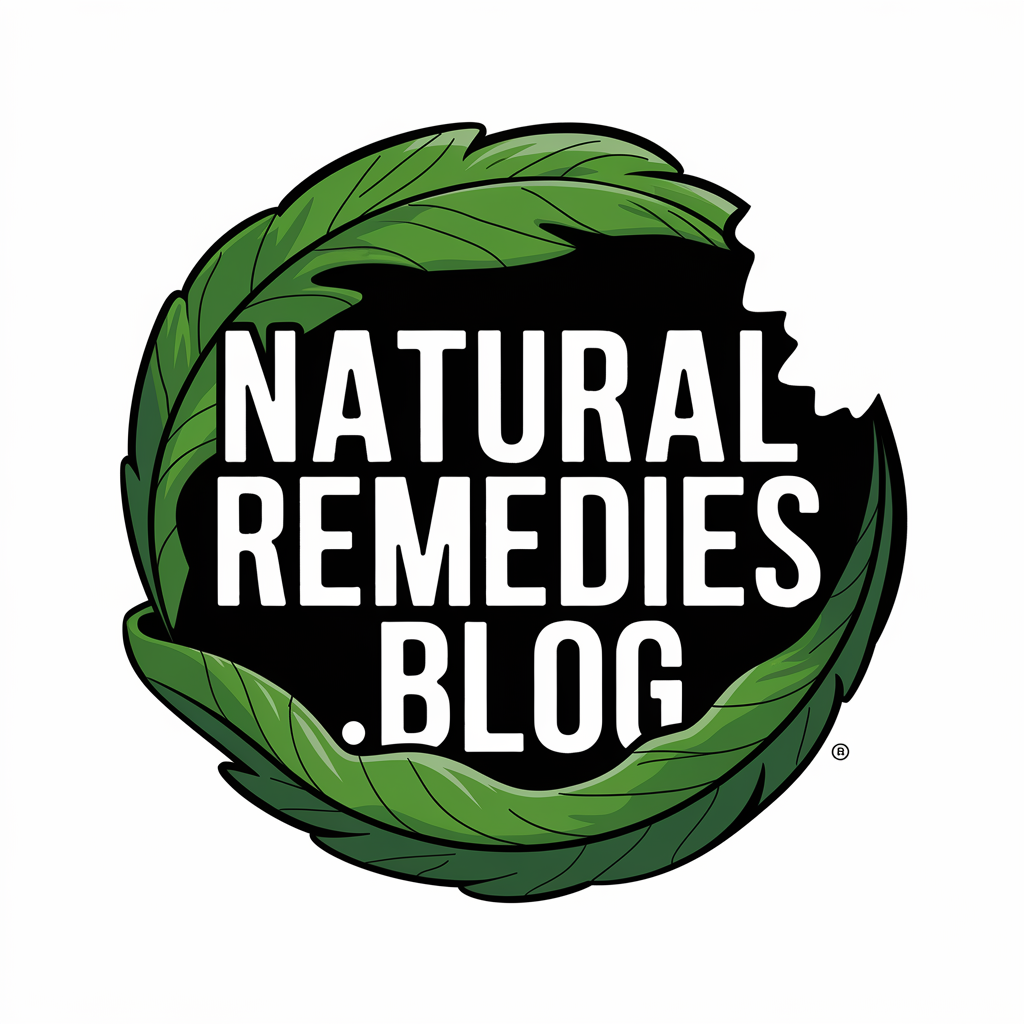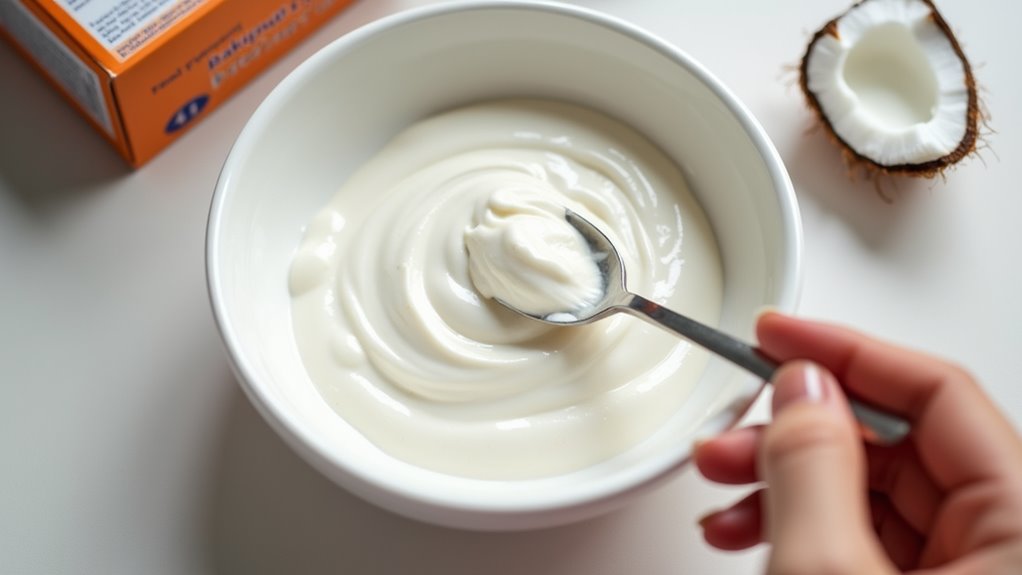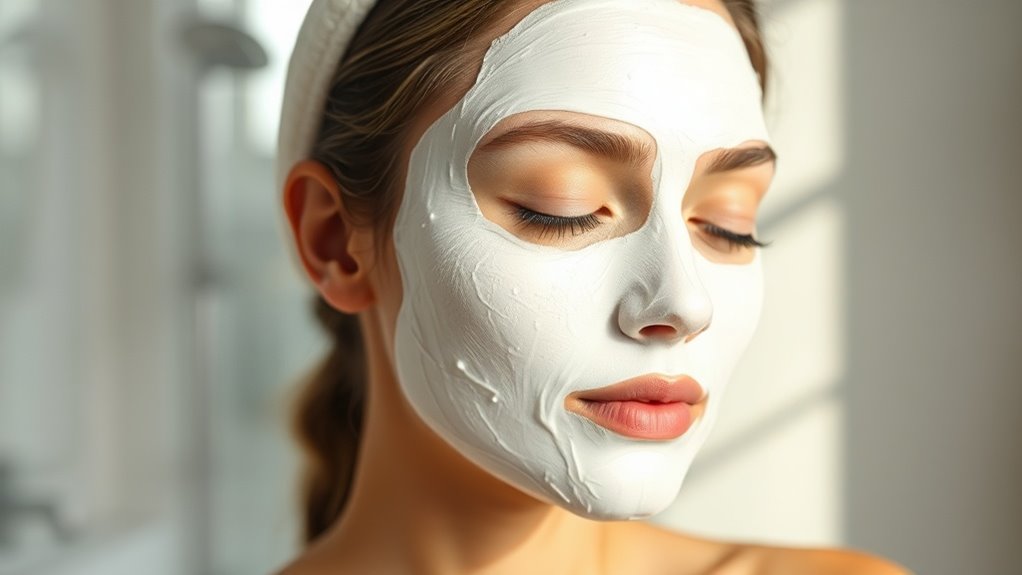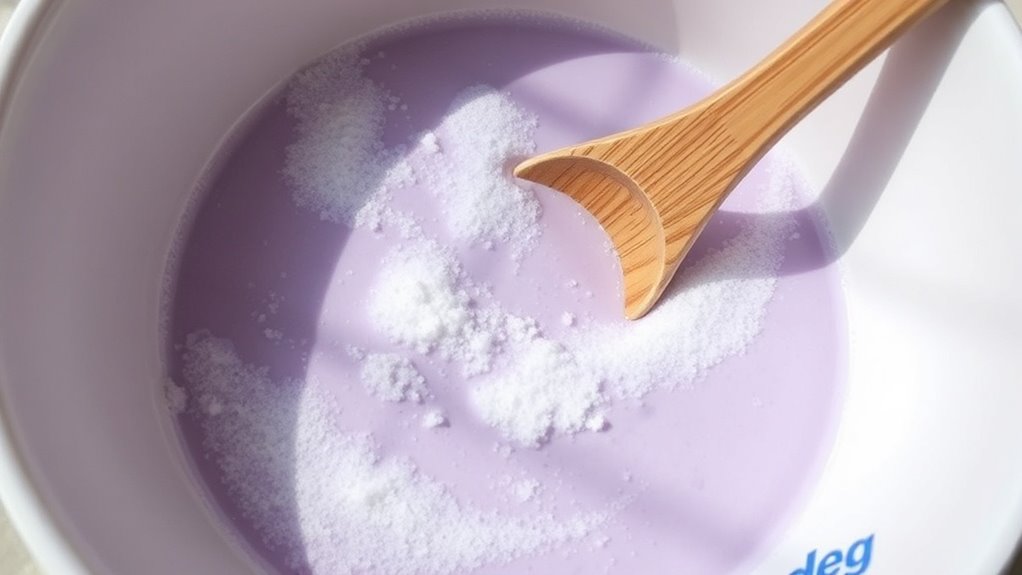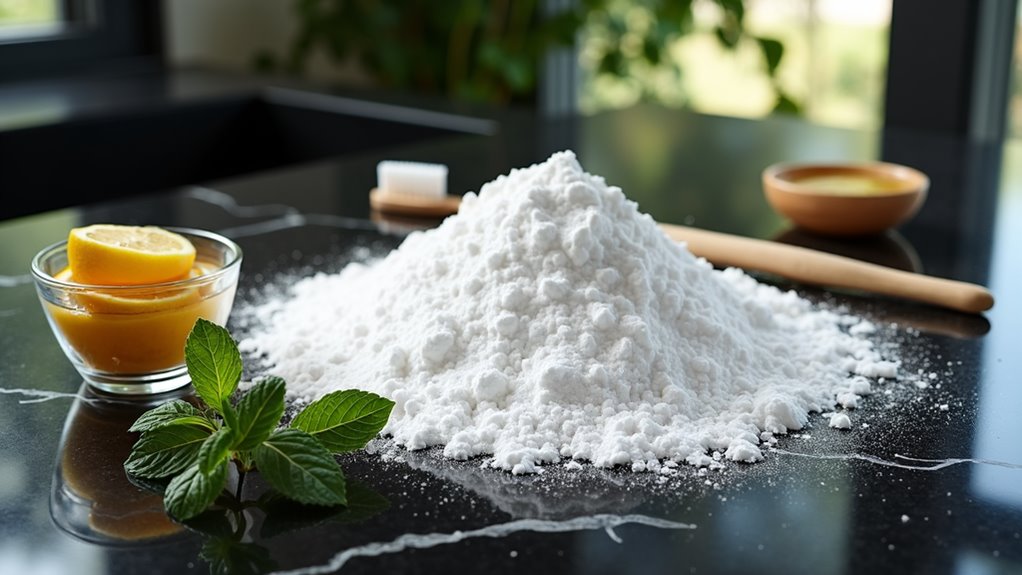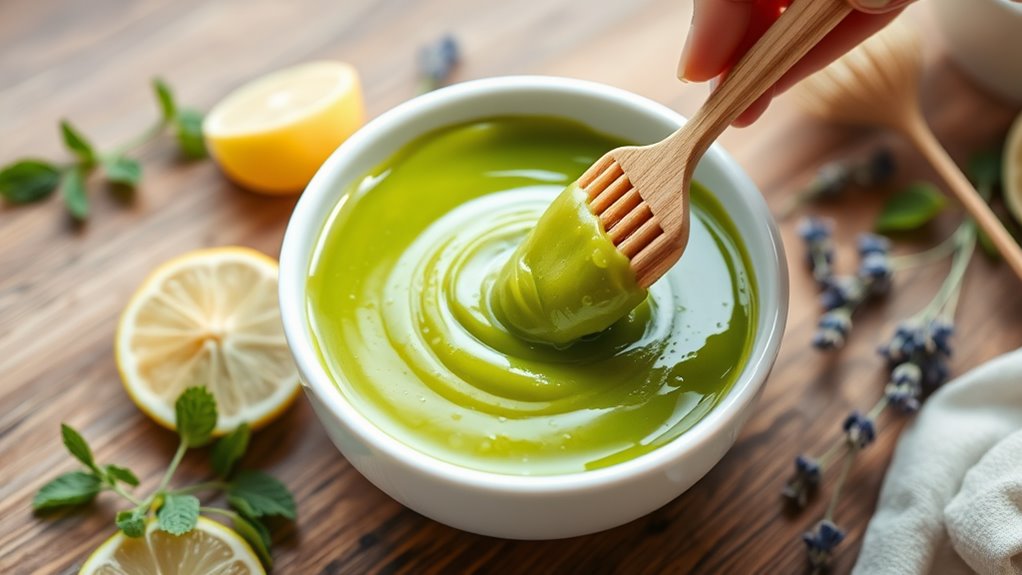Baking Soda Facelift Hack You Didn’t Expect!
Transform your skin with this simple DIY baking soda facelift hack. Mix two tablespoons of baking soda with honey and lemon juice to create a gentle exfoliating mask that buffs away dead skin cells and minimizes fine lines. Apply in circular motions for 30 seconds on each facial area, focusing on problem spots. You’ll notice smoother, more radiant skin after your first treatment. Discover how this pantry staple rivals expensive spa treatments for youthful results.
Key Takeaways
-
Mix baking soda with honey and lemon juice to create a natural facial mask that tightens and brightens aging skin.
-
Gentle circular motions during application stimulate blood flow and promote collagen production for firmer, youthful-looking skin.
-
Regular weekly treatments can minimize fine lines and wrinkles through consistent dead skin cell removal and pH balance restoration.
-
The crystalline structure of baking soda provides natural exfoliation while its pH-balancing properties help maintain skin elasticity.
-
Apply the mixture before bedtime to allow skin restoration during sleep, followed by moisturizer for maximum anti-aging benefits.
The Science Behind Baking Soda’s Exfoliating Power
While many expensive exfoliants line beauty store shelves, baking soda’s effectiveness comes from its fine, crystalline structure and mild abrasive properties.
When you create a baking soda face mask, you’re harnessing the power of sodium bicarbonate crystals that gently buff away dead skin cells without harsh scratching.
The magic lies in baking soda’s perfectly balanced pH level and uniform particle size. As you massage it into your skin, these tiny crystals work to unclog pores and remove the outer layer of dull skin cells.
You’ll notice your skin feels smoother because baking soda’s natural properties help dissolve the bonds between dead skin cells, making them easier to remove.
It’s the same science that’s made this kitchen staple a trusted beauty secret for generations.
Benefits of Using Baking Soda for Facial Care
The natural exfoliating power of baking soda leads to numerous skin benefits you’ll notice after regular use.
You’ll experience smoother, more even-toned skin as the gentle abrasion removes dead cells and unclogs pores. Many users report a visible reduction in blackheads and acne due to baking soda’s natural antibacterial properties.
Your skin’s pH balance can improve with careful application, helping to neutralize excess oils while maintaining essential moisture.
You’ll find that baking soda helps minimize the appearance of fine lines and wrinkles by promoting cell turnover. The ingredient’s anti-inflammatory properties can also reduce redness and puffiness, giving you a more refreshed look.
Best of all, you’re using an affordable, chemical-free alternative that’s likely already in your kitchen cabinet.
Essential Ingredients for Your DIY Face Mask
Creating this effective baking soda face mask requires just a few simple, natural ingredients you likely have at home.
You’ll need two tablespoons of pure baking soda as your base ingredient, plus one tablespoon of raw honey for its antibacterial properties. Add a splash of fresh lemon juice to brighten your complexion.
For extra nourishment, you can include one teaspoon of coconut oil, which helps restore moisture while the baking soda exfoliates.
If you’re looking to combat oily skin, mix in a few drops of tea tree essential oil. Those with sensitive skin might want to add a tablespoon of plain yogurt to make the mixture gentler.
Remember to choose organic ingredients when possible to avoid any unwanted chemicals coming into contact with your skin.
Understanding Your Skin Type Before Application
Before applying any DIY face mask, you must identify your specific skin type to achieve ideal results and prevent potential irritation. Your skin likely falls into one of these categories: oily, dry, combination, normal, or sensitive.
If you’ve got oily skin, you’ll notice shine and enlarged pores, while dry skin feels tight and may flake. Combination skin shows both oily and dry patches, typically with an oily T-zone. Those with normal skin experience balanced moisture and few imperfections. Sensitive skin often reacts to products with redness or irritation.
You can determine your type by washing your face and waiting an hour – observe how your skin feels and looks. If you’re unsure, try the blotting paper test: press it against different areas of your face to check for oil patterns.
Step-by-Step Mixing Instructions
Making your baking soda face mask requires three simple ingredients from your kitchen: pure baking soda, fresh lemon juice, and filtered water.
Start by combining one tablespoon of baking soda with half a teaspoon of fresh lemon juice in a small glass bowl. Add three drops of filtered water and mix the ingredients with a clean spoon until you’ve created a smooth paste.
If the mixture feels too thick, add one more drop of water at a time until you achieve a spreadable consistency. You’ll know you’ve got the perfect blend when the paste isn’t runny but spreads easily between your fingers.
The mixture should feel slightly gritty but not abrasive. Don’t make more than you need for one application, as this natural blend works best when fresh.
Proper Application Techniques
Once you’ve prepared the baking soda mixture, it’s important to apply it with clean, gentle hands using upward circular motions. Your skin deserves this pampering treatment, and you’ll want to make sure you’re getting the most out of this natural beauty ritual.
| Area | Application Method |
|---|---|
| Cheeks | Gentle upward circles |
| Forehead | Outward sweeping motions |
| Chin | Light upward strokes |
| Under Eyes | Feather-light tapping |
| Neck | Upward gliding strokes |
Focus on one area at a time, spending about 30 seconds on each section. Don’t rush – this is your moment for self-care. Remember to avoid pulling or tugging at your skin, as this can cause irritation. You’ll feel the gentle exfoliation working its magic while maintaining your skin’s delicate balance.
Recommended Treatment Duration
The recommended time for your baking soda facial treatment is 5-7 minutes total.
You’ll want to time yourself carefully, as leaving the mixture on for too long can irritate your skin. Start by massaging the paste onto your face for about 2 minutes, then let it sit for another 3-5 minutes.
For best results, use this treatment twice a week – just like your favorite spa treatments!
If you’re new to baking soda facials, start with just once a week to see how your skin responds. Those with sensitive skin should limit treatments to once every 10 days.
Remember to listen to your skin – if you feel any burning or excessive tingling, wash the mixture off immediately.
You’ll soon discover your perfect treatment schedule as part of your self-care routine.
Post-Treatment Skin Care
After rinsing off your baking soda mask with lukewarm water, it’s essential to restore your skin’s natural pH balance and moisture.
Apply a gentle, alcohol-free toner to rebalance your skin, followed by a hydrating serum rich in hyaluronic acid or vitamin B5.
Lock in the moisture with a nourishing cream, and don’t skip the sunscreen – your skin will be more sensitive after the treatment.
You’ll want to use at least SPF 30, even if you’re staying indoors. For the next 24 hours, avoid harsh skincare products like retinoids, acids, or exfoliants.
Keep your skin protected by staying away from direct sun exposure and hot showers.
If you experience any redness or irritation, apply a soothing aloe vera gel or chamomile-based moisturizer to calm your skin.
Common Mistakes to Avoid
While baking soda can provide exfoliating benefits, many people make critical errors that could damage their skin.
You’ll want to avoid scrubbing too hard, as this can create micro-tears in your skin’s surface. Don’t leave the mixture on for more than 2 minutes, and never use it more than once a week.
Another common mistake is creating a paste that’s too concentrated. You’ll need to mix baking soda with enough water to form a thin, smooth consistency.
Don’t combine it with harsh ingredients like lemon juice or vinegar, which can disrupt your skin’s pH balance.
If you’re using retinoids or other active skincare products, skip the baking soda treatment altogether. Your skin’s already getting exfoliation, and you don’t want to risk over-sensitizing it.
Safety Precautions and Warnings
Because baking soda can irritate sensitive skin, you’ll need to perform a patch test 24 hours before attempting this facial treatment.
Apply a small amount of the baking soda mixture behind your ear or on your inner arm and watch for any adverse reactions like redness, itching, or burning.
Don’t leave the baking soda mask on your face for more than 5 minutes, as prolonged exposure can disrupt your skin’s natural pH balance.
If you experience any discomfort, rinse immediately with cool water. Avoid applying this treatment around your eyes, nostrils, and mouth.
Skip this treatment if you have broken skin, active acne, rosacea, or eczema.
Remember to always follow up with a moisturizer, as baking soda can be drying.
Limit this treatment to once a week to prevent over-exfoliation.
Best Time to Apply Your Baking Soda Mask
The ideal time to apply your baking soda mask is during your evening skincare routine, when your face is clean and free from makeup or sunscreen. This timing allows your skin to fully absorb the mask’s benefits while you sleep, promoting natural cell turnover and rejuvenation.
You’ll want to set aside about 15-20 minutes for the entire process. Many skincare enthusiasts choose to apply their mask right after a warm shower, as the steam helps open up pores.
If you’re planning to do other facial treatments, apply the baking soda mask first, followed by your regular serums and moisturizers.
For best results, don’t apply the mask more than twice a week, and always leave at least three days between applications to prevent skin sensitivity.
Combining Baking Soda With Other Natural Ingredients
Mixing baking soda with other natural ingredients can enhance your mask’s effectiveness and create a more personalized skincare treatment.
You’ll love combining it with honey for added antibacterial properties, or lemon juice for brightening effects. For sensitive skin, mix your baking soda with yogurt to create a gentler, moisturizing blend.
Want to target specific concerns? Try mixing your baking soda with turmeric for inflammation, coconut oil for deep hydration, or apple cider vinegar for exfoliation.
You can also add a few drops of tea tree oil if you’re dealing with breakouts. Remember to start with a small amount of baking soda and gradually add your chosen ingredient until you achieve a paste-like consistency.
These combinations will give you the perfect DIY treatment that’s both natural and effective.
Expected Results and Timeline
While results can vary from person to person, you’ll typically notice initial improvements in skin texture after your first baking soda facial treatment. Your skin will feel smoother and look brighter immediately after the treatment.
For best results, you’ll want to follow a consistent routine. Within 2-3 weeks of regular use (2-3 times per week), you’ll start seeing more significant changes. Your pores will appear smaller, and your complexion will become more even-toned.
Long-term benefits emerge after 6-8 weeks of dedicated use. You’ll notice fine lines becoming less visible, and your skin will maintain a natural, healthy glow.
Just like other members of our natural skincare community, you can achieve that sought-after youthful appearance without expensive treatments or chemicals.
Cost Comparison With Commercial Treatments
Compared to expensive professional treatments, baking soda facials offer remarkable savings for your skincare routine. While professional chemical peels can cost between $150-$800 per session, you’ll spend just pennies per treatment using baking soda at home. A typical box of baking soda costs around $1 and can provide multiple facial treatments.
High-end spa facials often run $100-$300 per visit, and medical-grade treatments like microdermabrasion can set you back $75-$200 per session.
Even basic facial products from premium skincare brands can cost $30-$100 per bottle. When you’re looking to maintain that youthful glow without breaking the bank, baking soda treatments let you join the natural beauty movement while keeping your wallet happy.
Storage and Shelf Life Tips
Proper storage of baking soda extends its effectiveness for facial treatments up to 3 years past the printed date.
You’ll want to keep your baking soda in an airtight container, away from moisture, heat, and strong odors that it might absorb. A cool, dry pantry or cabinet is your best storage spot.
To check if your baking soda is still fresh, mix a teaspoon with a splash of vinegar – if it fizzes vigorously, it’s good to go.
If you’re using it regularly for facials, consider transferring a small amount to a separate container for your beauty routine, keeping the main supply sealed.
Don’t forget to mark the date you opened it, and always use a dry spoon when scooping to prevent moisture contamination.
Signs of Adverse Reactions
Although baking soda is generally safe for facial use, you’ll need to watch for signs that your skin isn’t tolerating it well. Stop using the treatment immediately if you notice redness, burning, stinging, or itching during or after application. These reactions suggest your skin barrier may be compromised.
Other warning signs include excessive dryness, flaking, or a tight, uncomfortable feeling that persists hours after treatment. You might also experience increased sensitivity to your regular skincare products or sunlight. Some people develop small bumps, breakouts, or a rash, which indicates inflammation.
If you’re part of our skincare community, you know that listening to your skin is essential. When in doubt, patch test the mixture on a small area first, and always discontinue use if you experience any discomfort.
Weekly Treatment Schedule
Since baking soda can be harsh on your skin, you’ll want to limit treatments to once or twice per week maximum.
Start with one weekly application to see how your skin responds, then gradually increase to twice weekly if you don’t experience any irritation.
Schedule your treatments for evenings when you won’t be exposed to direct sunlight afterward. Always follow up with a moisturizer and sunscreen to protect your newly exfoliated skin.
If you’re using other exfoliating products or active ingredients like retinol, space out your baking soda treatments to avoid over-exfoliation.
For sensitive skin types, stick to just one treatment per week and consider diluting the baking soda mixture with more water.
Listen to your skin – if it feels tight or irritated, extend the time between treatments.
Alternative Uses for Baking Soda in Skincare
Beyond its use as a facial treatment, baking soda offers several other beneficial applications in your skincare routine.
You’ll love using it as a gentle body scrub by mixing it with your favorite shower gel to tackle rough patches on elbows and knees. It’s also perfect for cleaning makeup brushes – just create a paste with water and watch the old product melt away.
For those dealing with underarm darkness, you can make a brightening paste by combining baking soda with lemon juice.
It’s also great for addressing oily scalp issues when added to your shampoo. Don’t forget to try it as a natural deodorant or use it to soothe itchy skin after bug bites.
You’re now part of a community that knows these trusted, natural skincare secrets.
Frequently Asked Questions
Can I Use Baking Soda Facemask While Getting Botox Treatments?
You shouldn’t combine baking soda masks with Botox treatments. It’s best to avoid any facial scrubs or masks around your treatment time. Consult your provider for specific post-treatment skincare recommendations.
Does Baking Soda Treatment Interfere With Prescribed Acne Medications?
You shouldn’t combine baking soda with acne medications as it can disrupt your skin’s pH and reduce their effectiveness. It’s best to stick with your prescribed treatments for ideal results.
Will Baking Soda Facemask Affect Permanent Makeup or Microbladed Eyebrows?
You’ll want to avoid using baking soda on microbladed brows or permanent makeup, as its abrasive nature can fade your investment prematurely and disrupt the pigments in your skin.
Can Teenagers Safely Use Baking Soda Face Masks?
You shouldn’t use baking soda masks as a teen – they’re too harsh for young skin. You’ll risk irritation and damage to your skin barrier. Try gentle, age-appropriate cleansers instead.
Does Altitude or Humidity Affect the Effectiveness of Baking Soda Masks?
You’ll find that humidity can make your baking soda mask feel different – it might get pastier in damp air. Altitude won’t affect it much, but you’ll want to mix carefully regardless.
